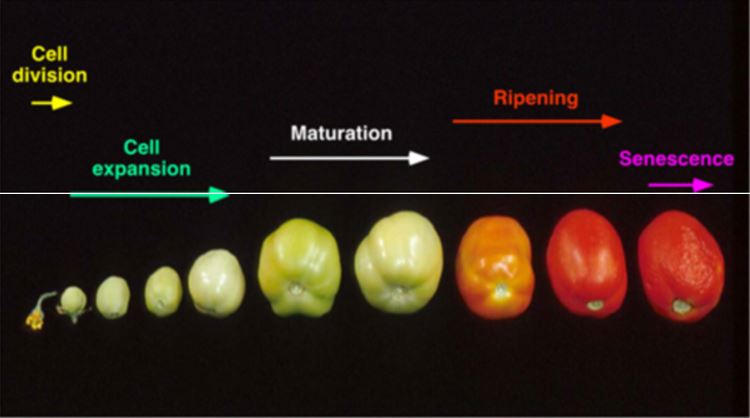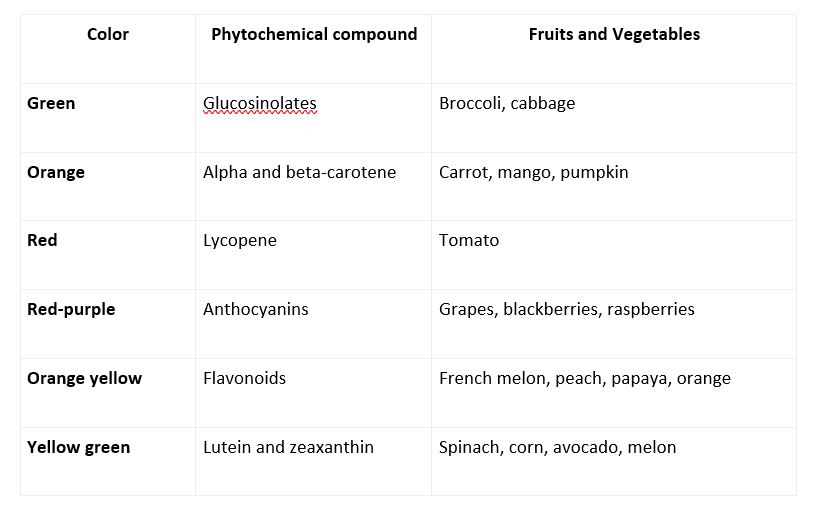April 16, 2019 at 11:57 pm | Updated April 16, 2019 at 11:57 pm | 6 min read
The Stages of Fruit Ripening
Fruit develops rapidly from a single cell to become the produce that ends up on our tables. Flower fertilization through pollen is the start of a fruit. The fruit goes through the growth stages of cell division, cell expansion, fruit maturity, and fruit ripening, then ends in fruit senescence. It is essential to estimate fruit growth, especially during maturity and ripening. There are many growth metrics available depending on the fruit or vegetable. Find out which one is appropriate for you.
Different Fruit Development
There are three parts to a fruit: the exocarp or skin, the mesocarp or the fruit flesh, and the endocarp. The initial stages of growth are similar in all fruits, where the fruit reaches maturity by accumulating solids. As different fruits begin to mature, they begin to follow different pathways.
The difference offers interesting ways to track their growth.

Subscribe to the Felix instruments Weekly article series.
By submitting this form, you are consenting to receive marketing emails from: . You can revoke your consent to receive emails at any time by using the SafeUnsubscribe® link, found at the bottom of every email. Emails are serviced by Constant Contact
Phases of fruit development and growth. “Reproduced from Plants in Action, http://plantsinaction.science.uq.edu.au, published by the Australian Society of Plant Scientists.
Appearance
The skin and flesh of the fruit can provide vital clues on the growth of the fruit. Since non-climacteric fruits have to remain on the trees or plants until the end, the development of their appearance can also be used to judge quality and readiness for harvest.
External and Internal Color
The skin of most fruits and vegetables change from green at the start. Changes in skin color occur due to pigments called carotenoids, which can be yellow, orange, red, green, purple, yellow-green, and orange-yellow. These are produced by fruits as part of the ripening process.
A change in internal and external color is one of the features used to see how the fruit is maturing and ripening.
- The development of external color can be used to track the growth of the fruit and decide when it is ready for plucking, and it has the advantage of being non-destructive.
- Checking internal color is a destructive process.
Though color charts are available for some fruits and vegetables such as peaches, apples, and tomatoes, in many cases some experience on the part of the grower is necessary to judge growth stages.
It is important to remember that the color development in fruits is also influenced by genetics, light, temperature, nutrient supply, crop-loads, and stress. So, color variations alone are not enough to track the growth of a fruit, as there can be variations year to year or within a region depending on many other factors.

Table credit: https://www.biolandeurope.com/en/the-colors-of-fruit-and-vegetables-and-their-properties/
Firmness
Besides color, ripening also changes the texture and consistency of the mesocarp or flesh making it soft. Firmness is the crispness of a fruit. One of the easiest ways to measure it is by applying pressure. There are several instruments available to test firmness called pressure testers and penetrometers. These are destructive as a probe is inserted into the fruit or pressure is applied to deform a fruit.
External and internal color of the fruit, and firmness can give information about ripeness, however, individually or even all three of them together are not sufficient to judge the nutritional value or quality of the fruit. Farmers usually follow the growth of fruits to fix harvest time. Since climacteric fruits are harvested after they mature, and before ripening, external features are inadequate growth metrics to judge harvest time.
Assessment of Fruit Composition
Production of carbohydrates spurs cell division, and its accumulation causes cell expansion and tissue differentiation. Here changes in size indicate growth of the fruit.
As the fruit grows to its full size, carbohydrates are converted to starch and sugars. There are several other compounds also formed such as organic acid, lipids, proteins, carotenoids, and volatile compounds. The fruit is a sink that attracts most of these compounds which are formed in the leaves as a result of photosynthesis.
These compounds are stored or metabolized as part of reactions, for example during the ripening and maturation. So, the concentration of these different components will change as the fruit develops. These changes help to accurately track fruit development. Some of the important compounds for this purpose are dry matter, starch, soluble solid content, titratable acidity, and Scoville units.
Dry Matter (DM)
When water is removed from the fruit, what remains is the dry matter, and this is a measure of all the components of the fruit: the total soluble solids, fibers, etc. DM increases as the fruit develop. As DM is also correlated with the quality of fruit, it is growing popular as an indicator of growth. There are many techniques to measure DM on the field using small hand-held instruments depending on Near Infrared (NIR).
Starch and Sugar
The development in fruits differs from the time they start to mature based on the starch-sugar dynamic, which is based on the fruit type. Even during maturation and ripening, carbohydrates are still being imported from leaves into the fruit in different forms.
- Climacteric fruits retain their solids in the form of starch and fats during maturation. These are converted to soluble sugars only in the ripening stage on the plant or even post-harvest.
- Non-climacteric fruits skip this stage of storing starch and directly produce sugars in their soluble form during maturation.
The content of starch can be estimated through DM; in some cases as in kiwis starch accounts for 50% of DM at the onset of maturity.
Fructose, sucrose, and glucose make up the soluble sugars concentration (SSC) of fruits and juices. As the fruit ripens their concentration increases making the fruit sweeter. BRIX can measure SSC.
Titratable Acidity
Organic acids are produced within the fruits, unlike the rest of the solids, which are imported from leaves. They can be metabolized from sugars or produced from carbon dioxide the fruit absorbs. The presence of acids makes the fruit sour, and their level is called titratable acids. The acid produced depends on the fruit. Thus, for example, citric acid is present in citrus, while grapes have tartaric acid.
The presence of these acids is desirable in the right concentrations, as they prevent the fruit from being bland or too sweet. The levels of acid are high in the initial stages of fruit development, making them tart. However, their levels decrease as the fruit ripens.
Scoville Units
Vegetables such as peppers and chillies are pungent due to the presence of the compound capsaicin. Wilbur L. Scoville developed the Scoville Organoleptic scale or test. Vegetables that are not pungent score zero on this scale, while habaneros score 300,000. The number indicates that the capsaicin has to be diluted 300,000 fold before it is undetectable.
Besides genetics, the pungency is affected by environmental factors such as temperature, hours of sunlight, moisture, and soil, and cultivational practices like fertilisers used. Scoville units of dried chillies will also depend on the conditions under which it is dried.
Selection of Metrics
Estimation of the fruit composition can be used to measure all kinds of fruits whether they are climacteric or non-climacteric. It is important to note that in many cases there may be no single instrument that has universal application. For example, the instruments which measure ripeness based on DM content are useful for most fruits, except avocados. So consult your peers or the company selling tools to be sure you are buying the right product.
—
Vijayalaxmi Kinhal
Science Writer, CID Bio-Science
Ph.D. Ecology and Environmental Science, B.Sc Agriculture
Sources
Atkinson, R. G., Brummell, D. A., Burdon, J. N., Patterson, K. J., & Schaffer R. J. (2015). Chapter 11 – Fruit growth, ripening and post-harvest physiology. In B. Atwell, P. Kriedemann & C. Turnbull (Eds.), Plants in Action. Retrieved from http://www.asps.org.au/wp-content/uploads/
Chapter-11-Fruit-growth-ripening-and-post-harvest-physiology.pdf
Brix: a measure of fruit sweetness. Retrieved fromhttp://www.davewilson.com/product-information/note/brix
Chapter 2. Basic harvest and post-harvest handling considerations for fresh fruits and vegetables. Retrieved from http://www.fao.org/3/y4358e/y4358e05.htm
Colours in vegetables, a work of chemistry. Retrieved from https://www.worldofchemicals.com/128/chemistry-articles/colours-in-vegetables-a-work-of-
chemistry.html
De Baerdemaeker J., Jancsók P.T., & Verlinden B.E. (2002). Firmness and Softening of Fruits and Vegetables. In: Blahovec J., Kutílek M. (eds) Physical Methods in Agriculture. Springer, Boston, MA. https://doi.org/10.1007/978-1-4615-0085-8_18
Escribanoa, S., Biasia, W.V., Lerudb, R., Slaughterc, D.C, & Mitcham, E.J. (2017). Non-destructive prediction of soluble solids and dry matter content using NIR spectroscopy and its relationship with sensory quality in sweet cherries.Postharvest Biology and Technology, 128 (112-120). https://doi.org/10.1016/j.postharvbio.2017.01.016
Marini, R. (2017, October 25). Fruit Color – Promoting Red Color Development in Apple. Penn State Extension. Retrieved from https://extension.psu.edu/fruit-color-promoting-red-color-development-in-apple
Sylvia T. 2013. Dry matter and fruit: Manipulation in the field and evaluation with NIR spectroscopy. PhD Thesis. Department of Food Science, AU Aarslev. Retrieved from
ttps://pure.au.dk/ws/files/56894564/Dry_matter_and_fruit_quality_manipulation_in_the_field_and_evaluation_Sylvia_Travers_Thesis
The colors of fruit and vegetables and their properties. (2017, October 17). Retrieved from
https://www.biolandeurope.com/en/the-colors-of-fruit-and-vegetables-and-their-properties/
The Scoville Heat Scale. Retrieved from https://www.chilliworld.com/factfile/scoville-scale
Related Products
- F-751 Grape Quality Meter
- Custom Model Building
- F-901 AccuStore
- F-751 Melon Quality Meter
- F-751 Kiwifruit Quality Meter
- F-750 Produce Quality Meter
- F-751 Avocado Quality Meter
- F-751 Mango Quality Meter
- F-900 Portable Ethylene Analyzer
- F-950 Three Gas Analyzer
- F-920 Check It! Gas Analyzer
- F-960 Ripen It! Gas Analyzer
- F-940 Store It! Gas Analyzer
Most Popular Articles
- Spectrophotometry in 2023
- The Importance of Food Quality Testing
- NIR Applications in Agriculture – Everything…
- The 5 Most Important Parameters in Produce Quality Control
- Melon Fruit: Quality, Production & Physiology
- Fruit Respiration Impact on Fruit Quality
- Guide to Fresh Fruit Quality Control
- Liquid Spectrophotometry & Food Industry Applications
- Ethylene (C2H4) – Ripening, Crops & Agriculture
- Active Packaging: What it is and why it’s important






